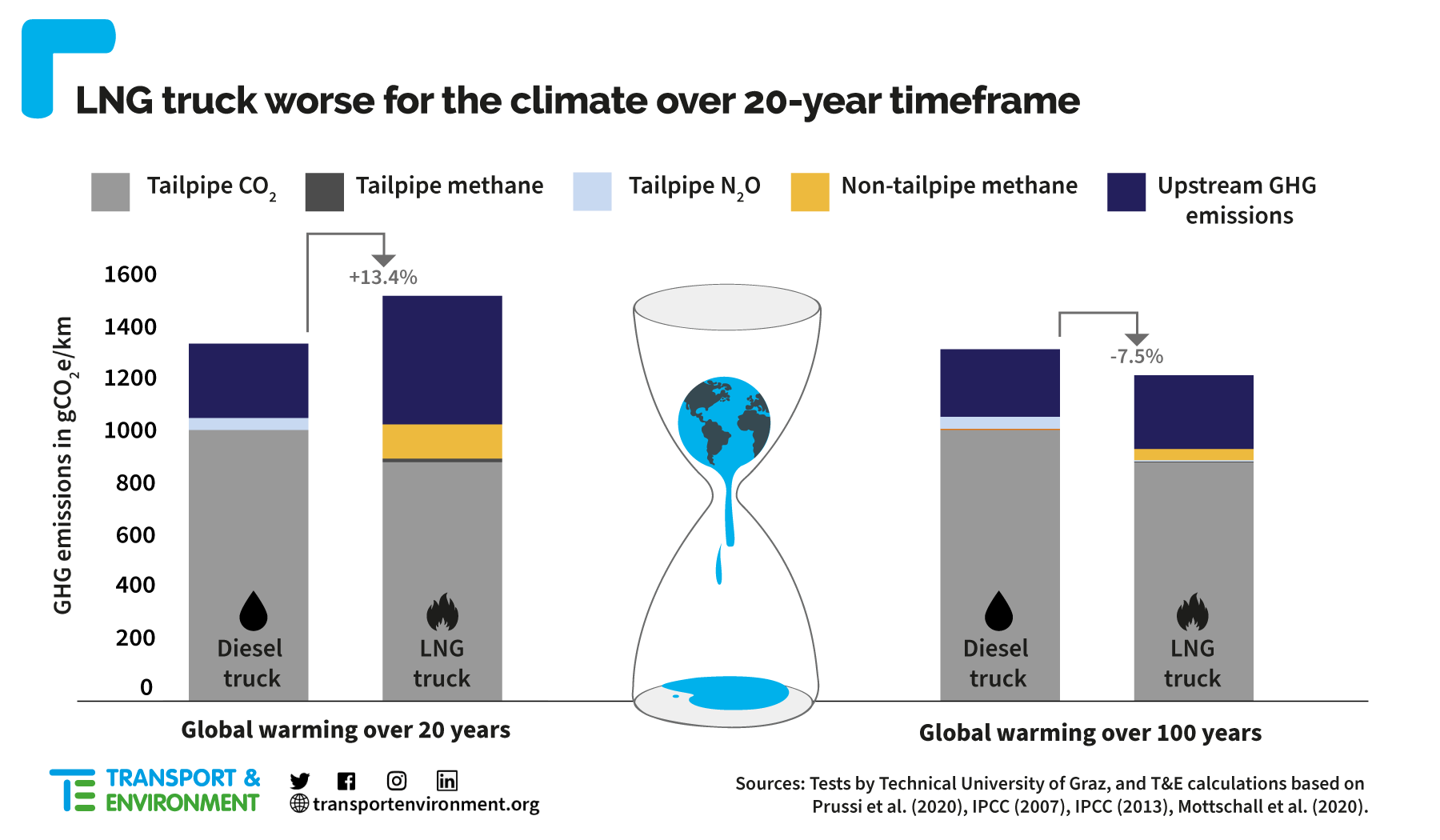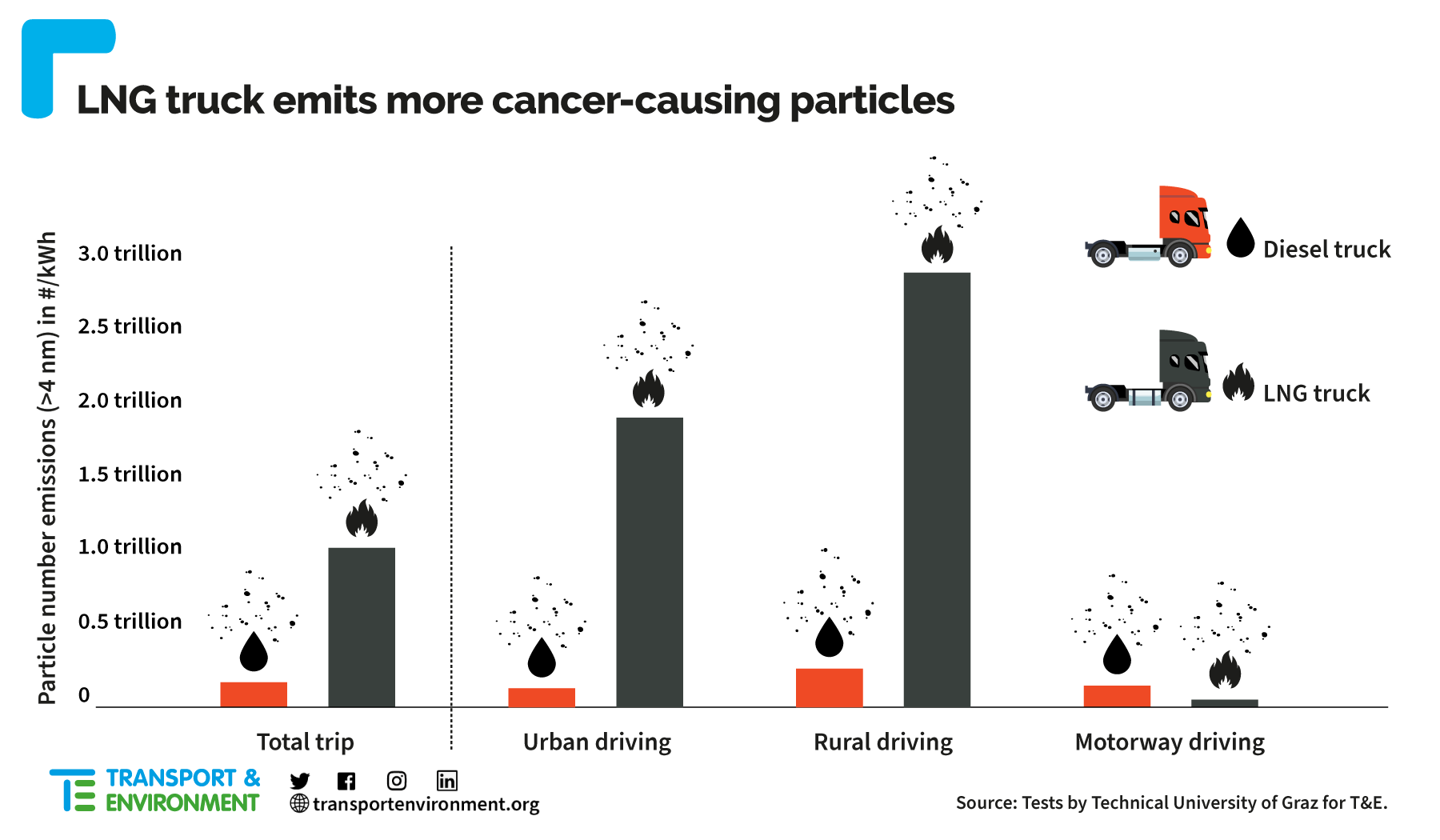Trucks powered by liquified natural gas (LNG) are no better for the climate than conventional diesel trucks and pollute the air far more than manufacturers claim, new independent tests indicate. Transport & Environment (T&E), which commissioned the on-road tests, said only zero-emissions trucks like battery electric vehicles should be supported by lawmakers. It called for gas fuelling stations to be kicked out of EU fuel infrastructure targets and an end to generous government subsidies for LNG trucks in all EU countries.
Iveco’s S-Way LNG truck emits 13.4% more greenhouse gases than its Stralis diesel truck over a 20-year timeframe, the analysis shows. As methane has a far greater warming impact than CO2 in the 20 years after its release, the recent IPCC report said rapidly reducing it is crucial to avoiding catastrophic temperature rises.

The gas truck’s emissions savings at the tailpipe are negligible, according to the Technical University of Graz, which tested for exhaust CO2, methane and nitrous oxide. T&E analysed methane venting and upstream greenhouse gas emissions. Over a 100-year timeframe, when methane is much less potent, the LNG truck emits just 7.5% less than the diesel.
Fedor Unterlohner, freight manager at T&E, said: “Gas trucks are a dead-end for cutting emissions and will even exacerbate the climate crisis today. Only emissions-free vehicles are capable of decarbonising trucking. It’s time for gas fuelling stations to be dropped from the EU’s infrastructure targets and for governments to stop incentivising the purchase of LNG trucks.”
T&E analysis also found that powering Europe’s trucks with renewable gas is not an option. Demand for biomethane by trucks in the six biggest European countries would far outstrip the amount available, even with generous subsidies.[1]

The LNG truck is also far worse for cancer-causing particle emissions in cities and rural driving. In tests it emitted 37 times more particles (PN) – including ultrafine particles which penetrate deep into the body and are linked with brain tumors [2] – than those that are measured in official tests. And while the gas truck performed better than the diesel for NOx emissions, it did not deliver the 90% savings that the truckmaker claims.[3]
Fedor Unterlohner said: “LNG trucks are held up as saviours of air quality, but tests show they pollute far more than manufacturers claim. They are also a lot worse than diesel for the smallest and most harmful particles, including in city driving, where they are used for deliveries. Ultimately, gas trucks are just another fossil fuel technology that can never clean up freight.”
T&E called on governments and MEPs to reject an EU proposal for countries to continue installing LNG fuel stations under the Alternative Fuel Infrastructure law. EU member states, such as Germany and Italy, should also end their fleet renewal and purchase incentives for LNG trucks. Other subsidies, such as the lower fuel duty for fossil gas in transport throughout Europe, should also stop. Next year, T&E said, the EU should set the date by when all new trucks must be zero emissions when it reviews the truck CO2 law.
Notes to editors:
[1] T&E modelled the availability of sustainable biomethane in Germany, the UK, France, Italy, Spain and Poland and compared it with the countries’ energy demand from trucks. Even with high subsidies equivalent to six times the retail price of natural gas, the six countries could only meet 4% to 28% of their expected road freight energy consumption in 2050 with biomethane. See analysis:
https://www.transportenvironment.org/discover/lng-trucks-a-dead-end-bridge/
[2] “Each 10,000/cm3 increase in UFP [Ultra Fine Particles] was positively associated with brain tumor incidence (HR = 1.112, 95% CI = 1.042, 1.188) after adjusting for PM2.5, NO2, and sociodemographic factors.”
Weichenthal, S., Olaniyan, T., Christidis, T., Lavigne, E., Hatzopoulou, M., Van Ryswyk, K., … & Burnett, R. (2020). Within-city spatial variations in ambient ultrafine particle concentrations and incident brain tumors in adults. Epidemiology (Cambridge, Mass.), 31(2), 177.
[3] Iveco and the gas vehicle industry typically claim gas trucks emit 90% less NO2 than diesel. However, focusing only on NO2 emissions ignores a large chunk of air pollution. NO is also emitted out of the exhaust and reacts in ambient air to become NO2. As such, emissions of both (combined as NOx) have to be considered.
https://viewer.ipaper.io/iveco-hq/UK/iveco-s-way/?page=28
Read more:
Report: LNG trucks – a dead-end bridge
EDIT: On 29 September 2021 this press release was edited to reflect that the LNG truck emitted 37 times more particles (PN) than those that are measured in official tests.


